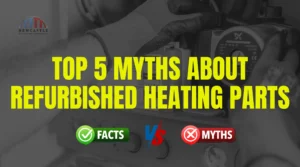How To Bleed a Radiator: A Simple Step-By-Step Guide
If your radiators aren’t heating up properly, air trapped inside the system may be the culprit. Bleeding your radiator can restore efficient heating and reduce wasted energy. This guide walks you through safely bleeding a radiator, with reference to expert advice from trusted sources.
Table of contents
What Is Radiator Bleeding?
Bleeding a radiator means releasing the air that has built up inside your heating system. That air prevents hot water from circulating properly, so the radiator ends up with cold spots or uneven heating.
Why Do Radiators Need Bleeding?
Look for these indicators:
- The top of the radiator is cool while the bottom is warm.
- Gurgling, bubbling or hissing sounds when the heating is on.
- Radiators take longer than normal to heat up.
- Increased energy bills tied to inefficient heating. (Bleeding regularly helps prevent this.)
Tools and Materials You’ll Need
Before you begin, gather:
- Radiator bleed key (or flat-head screwdriver for some models)
- A small bowl or rag/towel to catch any drips of water.
- Protective gloves.
- (Optional) A flashlight and towel under the radiator for extra caution.
Preparing to Bleed the Radiator
Turn off your heating system and allow the radiator to cool. This ensures you don’t get hot water spraying when you bleed.
Place the bowl or rag under the bleed valve to catch any water.
It is wise to keep children and pets clear of the work area while you’re doing this.
Step-by-Step: How to Bleed a Radiator
Time needed: 5 minutes
Follow the below given steps to bleed the radiator
- Locate the Bleed Valve
Find the small valve typically at the top of the radiator on one end. It will often have a square peg or slot for the key or screwdriver
- Open the Valve Slowly
Insert your key or screwdriver and turn the valve anticlockwise just a little. You’ll hear a hiss as the air escapes.
- Wait for a Steady Stream of Water
Once the hissing stops and water starts trickling out steadily, the air has been released. Catch the water in your bowl/towel.
- Close the Valve
Turn the valve clockwise to close it. Ensure it is tightly closed to avoid leaks. Wipe away any excess water.
- Repeat for All Radiators
Starting from the radiator farthest from the boiler and working toward it helps make sure displaced air doesn’t migrate to another radiator.
- Turn Heating Back On and Check
After bleeding, switch your heating system back on. Feel the radiators to ensure they’re heating evenly with no cold spots. Also check your boiler pressure if applicable.
Troubleshooting Common Issues
Valve stuck or painted-over: If the bleed valve won’t turn because paint has sealed it, you may need to carefully remove or clear the paint first.
Continuous water flow after closing: This may mean the valve is faulty. Seek professional help to avoid water damage.
Radiator still cold at top after bleeding: Might indicate a more serious issue – such as pump failure, sludge build-up or boiler pressure problems.
Preventing Air Buildup & Keeping Your System Healthy
1.Bleed radiators once a year, especially before the colder season.
2.Check for any leaks or pressure issues in your system.
3.Consider installing an automatic air eliminator valve if your system regularly traps air.
4.Regular heating system servicing by a professional can help avoid persistent issues.
Conclusion
Bleeding your radiators is a quick, low-cost maintenance task that can improve heating performance and reduce energy waste. By following the steps above you’ll help ensure your radiators heat evenly and your home stays comfortable. If you find the issue persists after bleeding, it might be time to call in a heating specialist.
Frequently Asked Questions
Can you bleed a radiator when the heating is on? No! It’s very important to make sure your heating is off, and the radiators are cool before you bleed them. This is because radiators are filled with water and air, which is what escapes when you open the valve (include link to new pressure release guide page).
Keep in mind that you shouldn’t get carried away and open your radiator valve entirely or keep it open for too long – too much water will pour out, and your boiler pressure will drop dramatically.
Over time, air can become trapped within your radiators, leading to cold spots and a less-than-optimal performance from your home heating devices.
We recommend bleeding your radiators at least once a year, preferably in autumn to make sure your heating system is in top condition for a new heating season. However, if you notice that your radiators feel cold at the top or are taking a long time to heat up, it may be necessary to take action sooner.
Slowly keep turning the valve anticlockwise until the hissing stops and water flows steadily. It could take a few seconds for the hissing to stop, or up to a minute. It depends on how much air is trapped in the radiator.




